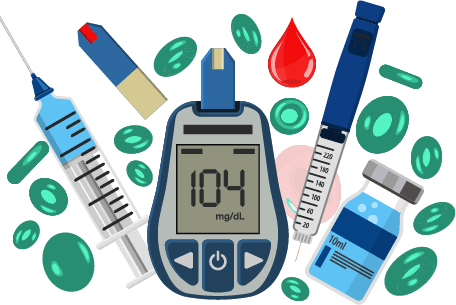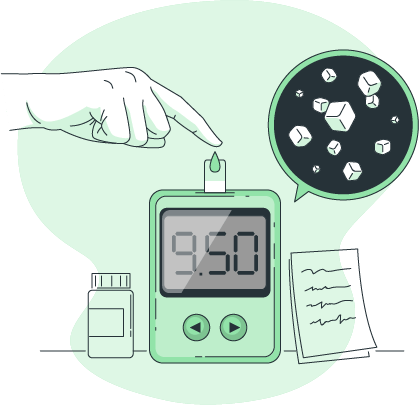“Glucose management is a game. The more you play the game the better you’re going to get…”
Phil Southerland
Phil Southerland is about to reshape your perception of living with type one diabetes. This episode offers inspiration to redefine metabolism and practical strategies to achieve glucose control.

Phil Southerland is the CEO and Co-founder of an all-diabetic pro cycling team, Team Novo Nordisk. 41 years ago, he was given the gift of Type 1 Diabetes, when the textbooks and science literature were not in favor of him being a master of his own metabolism.
He also works with Supersapiens, the most reliable continuous glucose monitoring (CGM) device to help his cycling team train for his goal to compete in the Tour De France. Throughout his life, he was given the tools to help him make his dreams a reality, and his dedication to having positive impacts in other people’s lives is obvious.
Phil’s inspirational journey from early diagnosis to professional cyclist is a testament to the resilience and determination anyone, diabetic or not, is capable of.
Listen to the full episode to hear how you can leverage the language of glucose to improve your life.
“We’re here to make a difference in people’s lives. But we are going to do so by pursuing our own dreams.”
Phil Southerland

Type 1 diabetes means that your pancreas does not produce insulin from beta cells to respond to glucose spikes in the blood. Normally, when glucose is high, insulin is released to scavenge the bloodstream and pull glucose out into the cells. When glucose circulates in your bloodstream for too long or becomes too high, this can cause a cascade of hyperglycemic symptoms.
⦁ Blurry vision
⦁ Hyperventilation
⦁ Vascular damage
Conversely, when blood sugar tanks, either from lack of eating, physical activity, or taking too much insulin, this can cause you to become hypoglycemic. Contrary to popular belief, hypoglycemia is the same in both diabetics and non-diabetics.
Back in the day, hypoglycemia would cause ‘dead in bed’ syndrome for diabetic athletes. All these years, Type 1 diabetics have been discouraged from intense physical activity, but Phil was able to overcome those doubters.
⦁ Brain fog
⦁ Fatigue
⦁ Muscle weakness
Remember when Phil said “glucose is a game”? Well, he’s right. The best way to manage your metabolism is by keeping glucose stable and preventing it from being too high or too low. You want your glucose to be just right.
There is not a doctor in the world that does not know about Team Novo Nordisk. For the past 18 years, they have been to every metabolic medical conference with their diabetic-cyclists in spandex. They have open communication with physicians about educating their patients on just going out and pursuing a goal, rather than just focusing on tight glycemic control.
When you control diabetes for the sake of a goal, whether it be to be a good biker or a student, or whatever your goal is, then there is a purpose and you won’t get burnt out if you have a purpose.
The trick..the magic bullet…for people with and without diabetes…is…movement. Once you go to the gym or do some form of physical activity, your metabolic stability for the next 18-24 hours is much easier to manage, and greatly improves.
“All it takes is 30 minutes of physical activity a day and you’re going to have an improvement in your metabolic health”
Phil Southerland
Phil has been an inspiration for other leaders in the metabolic to get up, exercise, and keep it moving. Even the chief science officer of CGM had struggled with being over weight. But Phil exemplifies what it means to go beyond yourself and share knowledge with others.
“Get a sensor, get a bike. 30 minutes per day. Speed doesn’t matter.”
Phil Southerland
There is an opportunity for everyone to improve their glycemic control. It is different for everyone, per your speed, per your goal. Whatever the goal is, you can optimize your glucose. By using a CGM, you can track in real time the fluctuations in your glucose. But don’t worry, because even the top 1% athletes have glucose that is out of control.
Education is at the forefront of KYP’s mission and what Phil does within all his endeavors (Supersapiens, Team Novo Nordisk, Type Team One). He educates about reality, what’s possible, what you can control, and how to obtain the data. Scientific publications are critical because if it’s not peer reviewed, it could just be magic fairy dust. In the years to come, Phil hopes to rewrite textbooks.

As a native from Atlanta, Georgia — the birthplace of Coca-Cola, Phil refuses to say “don’t drink coke”. He always knew it was treacherous, but he would still drink three to four colas per day.
When he started wearing Supersapiens, he saw his glucose spike up to 200 and the impending crash that followed.
In order to have your cake and eat it too, try drinking Coke at the end of your exercise or during your exercise so that your muscles eat up the sugar from the drink.
Every day, the speed of your metabolism changes. As the stress in your life changes, how your body responds to your input is also going to change. It’s not so much about what’s happening to your glucose, but what do you need to do to mitigate that spike?
If your glucose is trending up, try:
⦁ Going on a 15-20 minute walk
⦁ Drinking water to dilute your blood
⦁ Nasal breathing using your diaphragm
As you begin to use continuous glucose monitoring, you will be able to trial and error what is best for you to mitigate your glucose spike.
“It’s really helped me as a person who’s been a master of my metabolism for many, many years. I’ve got to learn from a lot of people without diabetes.”
-Phil Southerland
Through trial and error, Phil has learned that if he didn’t train yesterday and he works out today, his glucose is going to go up and he doesn’t need food for about two hours typically. But, if he did a decent training session yesterday and he goes out to exercise today, then he’ll need to eat within the first 30 minutes because his metabolism has moved. Exercising two days in a row changes the algorithm of how you fuel.
Three of Phil’s friends did a bike race together and their average glucose for a four hour race was 172, 178, 179 relatively similar. The difference for the first three hours was more variability between their glucose. But the one consistency among all three was at the three hour mark, all their glucose started going down.
Phil wondered if their muscle glycogen was empty were they not having as much access to liver glycogen? Did they not eat enough in an hour or two?
He self-reflected his own experiences of a glucose spike at 2.5 hours into the race, which he would normally inject insulin for, but he then remembered the huge crash that followed at the 3
hour mark. Now he let’s his glucose ride high for 30 minutes and wait for the three hour mark for it to descend.
The more you #KnowYourPhysio , you can optimize your life just like Phil is doing!
Things You can Expect during Endurance:
⦁ Glucose spike at 2.5 hours
⦁ Glucose downtrend at 3 hours
Anyhow, we are all different. What you do / what works for you is different than what works for Phil. Glucose management is a game. The more you play the game the better you’re going to get the more you play the game the better you’re going to learn how to react.
“Once you understand the language of glucose, you’ll realize you need a continuous glucose monitor on your arm 24/7 because you always have a chance to be a little bit better.”
-Phil Southerland
Ironically, Phil’s Libre3 high glucose sensor went off during the podcast. Why? Because when you’re speaking, you are inevitably mouth breathing, and mouth breathing will cause your glucose levels to rise and your heart rate variability (HRV) to fall. Which is exactly what happened to Phil on air.
Once you stop talking and get the chance to breathe diagrammatically using your nostrils, pausing between inhale and exhale, you will tip your stress response to a more parasympathetic state, thus lowering your glucose.
When to use breath work:
⦁ Before a business meeting
⦁ Before bed
⦁ After a stressful or inconvenient situation
⦁ Dealing with a loved one at a difficult time
⦁ Being in a race environment
Breath is the most accessible way to influence your physiology. When you start nasal breathing, you are creating that cardio inhibitory response to help improve your glucose levels. Later on in the episode, we saw Phil’s glucose trend down after nasal breathing
“When you asked, what was that beep? I was 164 going up. I breathed cautiously for a couple of minutes and now I’m 161 flat. So we now have data that breathing is faster than insulin”
-Phil Southerland
Your body where and how much glucose it needs. On top of that, it does a really great job of getting it there. Everyone respond to stress differently. Some people are trigger by being in the car with their wife, others when working on the trader floor, or going into an emergency room, while others have no stress at all in those situations. All of this is to say, stress is individual.
If you know you have a stressful scenario coming up in your day, let’s get your metabolism firing because you might have a stress response and your glucose might go up. But if your muscles are there, and they are hungry, then they’re going to absorb it quickly for fuel. If not, your body responds with insulin and causes a rapid crash called reactive hypoglycemia.
Reactive hypoglycemia is a moment of weakness that you’re going to have in your day. A non-diabetic body will correct it with the glucagon which is released as glycogen by the liver but you’re still going to have 15 to 20 minutes of cognitive weakness or physical weakness with that reactive hypoglycemia
If your glucose is trending down, try:
⦁ Taking a break
⦁ Going on a 15 minute walk
⦁ Light resistance training
If you don’t stop and let your muscles take in that glucose for fuel, your body is going to produce insulin, and that fuel in your bloodstream is going to get converted into fat. Cortisol is the precursor to the brown fatty tissue in your low gut. Think about it…
“If you don’t use the fuel that is in your bloodstream, it’s going to get converted into fat eventually. So find little ways to ensure you prioritize some form of activity throughout the day.”
-Phil Southerland
After all this deep discovery of glycemic control, Phil found that the exercise is the absolute best. Which makes sense that staying active 6 days a week and resting one day is fundamental to peak performance health optimization. Finding an activity that is enjoyable for you is key to longevity. Don’t just go running, cycling, swimming, etc. because that’s how other people achieved it. Dig deeper into your unique and authentic curiosities. Do you want to play tennis? Or hike? Or breakdance? There are magnanimous ways to move your body for glycemic control.
Quick Wins for Exercise:
⦁ Exercise in the morning
⦁ The worst time to eat is 23-90 minutes before exercise
…the more you #knowyourphysio…
Try to do some activity in the morning. By mobilizing your metabolism with movement, your heart and muscle are hungry for the stressors of the day. Have you ever felt your heart pounding through your chest when you’re having a conversation or giving a presentation? Well, that same heart is beating the same way when you exercise.
The reality is that stress is ongoing. What’s important is learning how to mitigate it so you do not burn yourself out and you can live a long life and achieve many things.
“Exercise everyday because (1) it clears the head from past stress and (2) it prepares the body for the next stress.”
-Phil Southerland
Exercise, especially endurance training, is suffering with a known endpoint. No matter how much you did not want to do it beforehand, the moment you’re out there you feel exponentially better.
Phil’s Pillars of Health:
⦁ Activity
⦁ Nutrition
⦁ Sleep
⦁ Mental health
“At the center of this is exercise because when you’re active you typically eat better, and you typically sleep better because you get more glucose stability over night.”
-Phil Southerland
In this episode, Phil seems especially sure of one thing – exercise for all, including himself who was discouraged from activity due to his type one diabetes diagnosis. Not only did he defy those odds, but he is the manifestation of his own dream – forming a pro-diabetic bike team, where
group suffering during their long rides is a deep connective experience. Imagine a group of dudes in spandex, peddling, sweating, and breathing, while everyone’s bloodstream is circulating with endorphins and oxytocin!
“Without movement, none of your dreams will come true.”
-Phil Southerland
SuperSapiens is going live with a daily score to help summarize your glucose data. They understand the language of glucose and want to educate people how to play the glucose game, and ways to hack the system.
Exciting things coming up:
⦁ Expansion to United States
⦁ Apple Integration for European users
This device is really valuable in helping you harness interception – deep bodily awareness – when you know how your glucose fluctuates throughout the day. The device is a small white disk that is placed on the back of the arm and integrates with any smart device.
“I want all our consumers to be active and feel better doing so.”
– Phil Southerland
“Let’s try to look beyond ourselves as individuals and look at who our friends and family are that could be struggling right now and tell them about our addiction to activity. Let’s try to spread it more.”
-Phil Southerland
Supporting Evidence
- Bergenstal, R. M., Ahmann, A. J., Bailey, T., Beck, R. W., Bissen, J., Buckingham, B., Deeb, L., Dolin, R. H., Garg, S. K., Goland, R., Hirsch, I. B., Klonoff, D. C., Kruger, D. F.,
Matfin, G., Mazze, R. S., Olson, B. A., Parkin, C., Peters, A., Powers, M. A., Rodriguez, H., … Wesley, D. M. (2013). Recommendations for standardizing glucose reporting and analysis to optimize clinical decision making in diabetes: the ambulatory glucose profile. Journal of diabetes science and technology, 7(2), 562–578. https://doi.org/10.1177/193229681300700234 - McCarthy, O., Eckstein, M. L., Scott, S. N., Fontana, F. Y., Christiansen, M. P., Stettler, C., Fisher, M., Bode, B., Riddell, M. C., Hayes, C., Lagrou, P. L., Southerland, P., Moser, O., & Bracken, R. M. (2020). Glycemic responses to strenuous training in male professional cyclists with type 1 diabetes: a prospective observational study. BMJ open diabetes research & care, 8(1), e001245.
https://doi.org/10.1136/bmjdrc-2020-001245 - Bolli, G. B., Deeb, L. C., Garg, S. K., Leahy, J. L., Mazze, R. S., Owens, D. R., Riddle,
M. C., Southerland, P., & Strock, E. S. (2011). International Forum for the Advancement of Diabetes Research and Care, April 29-30, 2011, Athens, Greece. Diabetes technology & therapeutics, 13(9), 967–979. https://doi.org/10.1089/dia.2011.0179 - Scott, S. N., Christiansen, M. P., Fontana, F. Y., Stettler, C., Bracken, R. M., Hayes, C. A., Fisher, M., Bode, B., Lagrou, P. H., Southerland, P., & Riddell, M. C. (2020).
Evaluation of Factors Related to Glycemic Management in Professional Cyclists With Type 1 Diabetes Over a 7-Day Stage Race. Diabetes care, 43(5), 1142–1145. https://doi.org/10.2337/dc19-2302 - Bergenstal, R. M., Ahmann, A. J., Bailey, T., Beck, R. W., Bissen, J., Buckingham, B., Deeb, L., Dolin, R. H., Garg, S. K., Goland, R., Hirsch, I. B., Klonoff, D. C., Kruger, D. F.,
Matfin, G., Mazze, R. S., Olson, B. A., Parkin, C., Peters, A., Powers, M. A., Rodriguez, H., … Wesley, D. M. (2013). Recommendations for standardizing glucose reporting and analysis to optimize clinical decision making in diabetes: the Ambulatory Glucose Profile (AGP). Diabetes technology & therapeutics, 15(3), 198–211. https://doi.org/10.1089/dia.2013.0051






